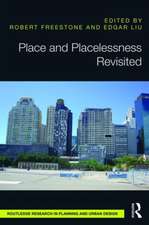The Efficacy of Architecture: Political Contestation and Agency
Autor Tahl Kamineren Limba Engleză Hardback – 12 dec 2016
At the centre of this rebellion is the call for architecture to (re-)assume its social and political role in society. The Efficacy of Architecture supports the return of architecture to politics by interrogating theories, practices and instances that claim or evidence architectural agency. It studies the political theories animating the architects, revisits the emergence of reformist architecture in the late nineteenth century, and brings to the fore the relation of spatial organization to social forms. In the process, a clearer picture emerges of the agency of architecture, of the threats to as well as potentials for meaningful societal transformation through architectural design.
| Toate formatele și edițiile | Preț | Express |
|---|---|---|
| Paperback (1) | 325.44 lei 6-8 săpt. | |
| Taylor & Francis – 7 dec 2016 | 325.44 lei 6-8 săpt. | |
| Hardback (1) | 990.57 lei 6-8 săpt. | |
| Taylor & Francis – 12 dec 2016 | 990.57 lei 6-8 săpt. |
Preț: 990.57 lei
Preț vechi: 1368.72 lei
-28% Nou
Puncte Express: 1486
Preț estimativ în valută:
189.55€ • 202.69$ • 158.04£
189.55€ • 202.69$ • 158.04£
Carte tipărită la comandă
Livrare economică 17 aprilie-01 mai
Preluare comenzi: 021 569.72.76
Specificații
ISBN-13: 9781138909854
ISBN-10: 1138909858
Pagini: 218
Ilustrații: 27
Dimensiuni: 174 x 246 x 16 mm
Greutate: 0.66 kg
Ediția:1
Editura: Taylor & Francis
Colecția Routledge
Locul publicării:Oxford, United Kingdom
ISBN-10: 1138909858
Pagini: 218
Ilustrații: 27
Dimensiuni: 174 x 246 x 16 mm
Greutate: 0.66 kg
Ediția:1
Editura: Taylor & Francis
Colecția Routledge
Locul publicării:Oxford, United Kingdom
Public țintă
Postgraduate and UndergraduateCuprins
Introduction: The Return to Politics. Part 1: Critique, Reformism and Co-Optation Critique and Change. The Ascent of Reformism. The Integration of Critique Part 2: The Architecture of Radical Democracy The Post-Fordist City. Theories of Participation. Theories of Contestation. Praxis Part 3: Languages of Architecture The Political as the Symbolic. Urban Form. ‘Vulgar’ Architecture, ‘Vulgar’ Politics. Notes. Bibliography. Index.
Notă biografică
Tahl Kaminer is Senior Lecturer in Architectural Design and Theory at the University of Edinburgh, UK. He co-founded and edited the journal Footprint. His publications include the monograph Architecture, Crisis and Resuscitation (Routledge, 2011) and the co-edited anthologies Houses in Transformation (2008), Urban Asymmetries (2011) and Critical Tools (2012).
Recenzii
‘The Efficacy of Architecture: Political Contestation and Agency is a book like no other I have come across. Equally familiar with architectural projects, the media’s use of those projects, and theories past and present that guide and critique those projects – it offers an insight into how socially motivated architects, urbanists, and theorists have been misrepresented and marginalized. In essence, this book is an in-depth examination of architectural ideology: how media, theory, philosophy, criticism, and design intertwine and morph as need be to silence politically engaged, participatory architecture. That this examination brings together actors not normally associated with each other around specific (largely Western) historical, intellectual and economic events is, to a large extent, its novelty; that the groupings nevertheless seem so obvious when explained by Kaminer, is proof that his argument (the obscuring of architectural critical history) is spot on. This book is insightful about the co-optation of publicly-minded work, but its analysis is ultimately not depressing; it offers precise direction for those so-minded to maneuver dexterously through our complex 21st century politico-economic system.’ - Peggy Deamer, Yale University, USA
Descriere
The Efficacy of Architecture supports the return of architecture to politics by interrogating theories, practices and instances that claim or evidence architectural agency. It studies the political theories animating the architects, revisits the emergence of reformist architecture in late-nineteenth-century, and brings to the fore the relation of spatial organization to social forms.





















